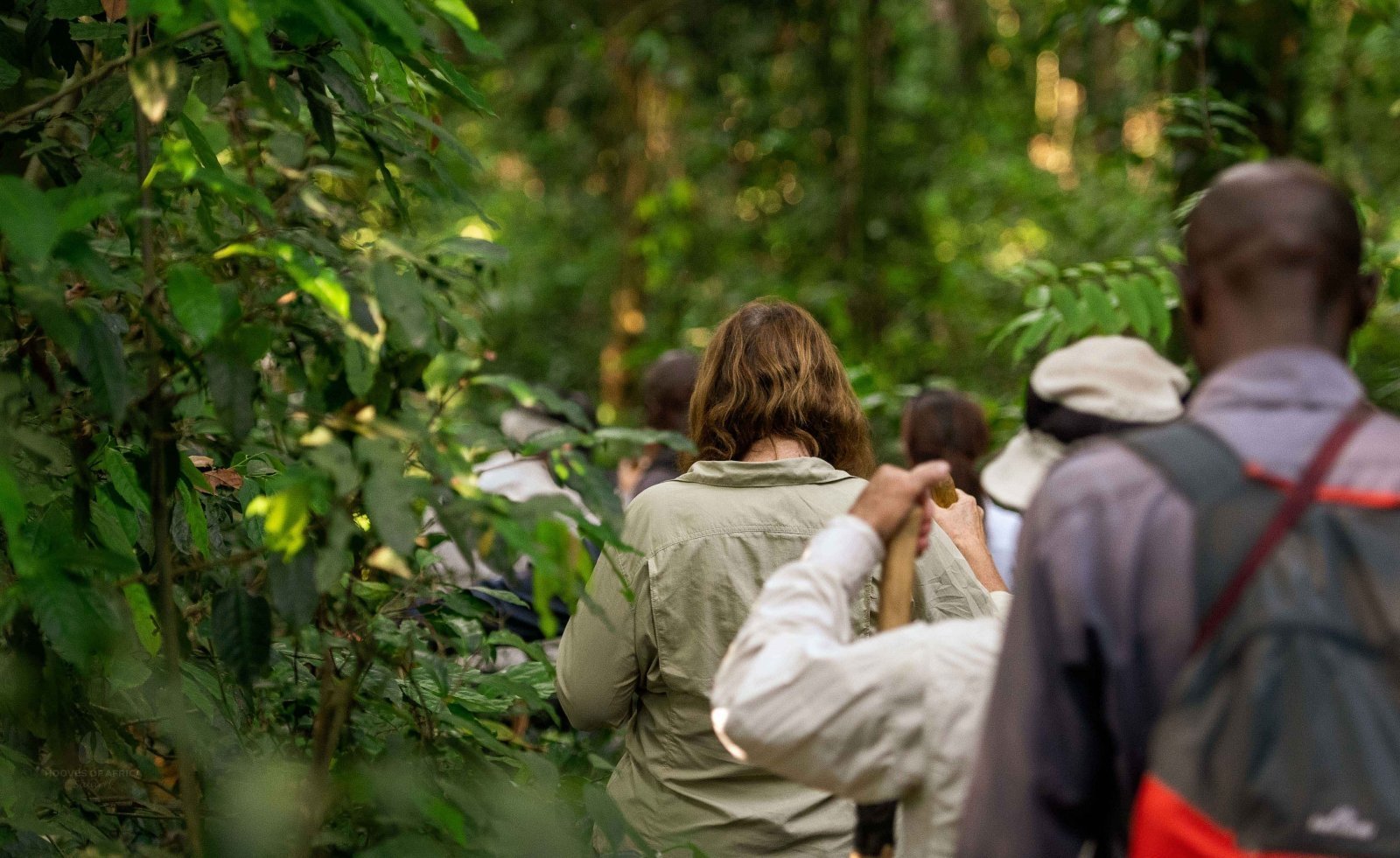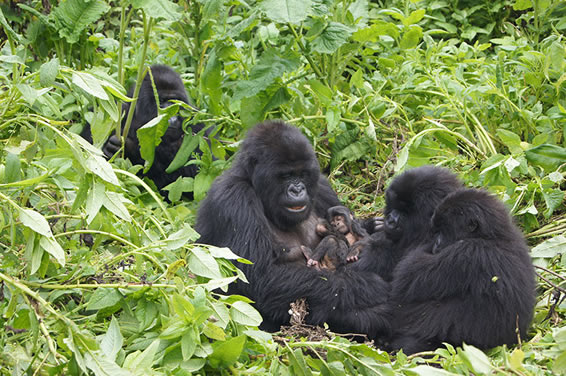2 Days Uganda Gorilla Safari Itinerary: An Epic Short Gorilla Safari
2 Days Uganda Gorilla Safari: Imagine stepping into a world where ancient rainforests whisper secrets of the wild, and majestic silverbacks command your awe with a single glance.
Uganda’s 2-day gorilla safari in Bwindi Impenetrable National Park isn’t just a trip—it’s a soul-stirring encounter with one of Earth’s rarest treasures: the endangered mountain gorillas.
Home to nearly half the world’s remaining 1,060 or so mountain gorillas, Bwindi offers an intimate, life-changing experience that’s more affordable and accessible than its Rwandan counterpart.
This compact itinerary is designed for time-strapped adventurers, blending thrilling treks with cultural immersion and serene retreats.
Whether you’re flying in from Entebbe or crossing from Kigali, Rwanda, prepare for 48 hours of raw, unfiltered magic. But before we dive in, let’s cover everything you need to know to make this adventure seamless and safe.

Detailed Itinerary of the 2 Days Uganda Gorilla Safari
Day 1: Arrival, Immersion, and the Brink of Wonder
Your adventure ignites at dawn as you embark on an epic road journey from Entebbe. At 5 AM, your private 4WD safari vehicle, driven by a seasoned guide from Gorilla Nest Safaris, awaits at your Entebbe hotel.
The 8–10 hour drive (460 km) to Bwindi’s Buhoma sector unfolds like a tapestry of Uganda’s soul—rolling savannas, tea estates, and the rugged Albertine Rift.
Your guide shares tales of Bwindi’s 1993 trekking inception and its 1994 UNESCO nod, punctuated by stops for photos and snacks.
Around 9 AM, pause in Mbarara for a quick Rolex (chapati-wrapped eggs, $1)—Uganda’s beloved street food—and strong roadside coffee.
The route snakes through terraced hills farmed by the Bakiga people—women in vibrant gomesi skirts tend banana groves, children wave from mud-brick homes. Cresting the Kanungu escarpment, Lake Bunyonyi’s shimmering waters and terraced slopes dazzle.
Arrive at Buhoma Lodge by 2 PM, welcomed by the humid, verdant embrace of pungent earth, wild orchids, and distant birdcalls.
Check into your thatched banda: wooden decks overlook the forest fringe where colobus monkeys swing like acrobats. Freshen up with a bucket shower (hot water on demand) and sip a gin-and-tonic, the Muhavura volcano silhouetted against the sky.
Post-lunch—matooke (steamed plantains), tilapia, and mangoes—it’s time for cultural awakening. At 3 PM, a 30-minute hike leads to the Batwa Experience Village ).
These forest pygmies, standing 4–5 feet tall, were evicted when Bwindi became a park in 1991 but now thrive through eco-tourism.
Clad in bark-cloth skirts, they demonstrate ancestral hunting with bows (pretend arrows), mimic gorilla chest-beats, and dance rhythmically around a bonfire.
A grandmother shares tales of honey-foraging in “the dark place” (Bwindi’s local name), her eyes twinkling as kids giggle at your clumsy bow attempts. It’s humbling—your trek tomorrow honors their legacy, funding schools and clinics.
As dusk falls (~6:30 PM), enjoy sundowners: Tusker beer or waragi (banana gin) on the veranda, spotting fireflies and hearing hyrax “screams” (like dolphin calls).
Dinner at 7:30 PM—peanut-sauced chicken luwombo, posho (maize porridge), cassava leaves—is candlelit amid lodge chatter from fellow trekkers swapping Rwanda-Uganda tales. Retire by 9 PM, lulled by frog choruses, for tomorrow’s briefing. Pro tip: Set your alarm for 5:30 AM—the forest calls.
Day 2: The Trek of a Lifetime and Farewell to the Giants
Rise with the mist-shrouded dawn. Breakfast at 6 AM—porridge, eggs, pineapple, and coffee from Bwindi’s volcanic soils—fuels your spirit.
By 7 AM, you’re at the UWA headquarters in Buhoma, a bustling hive of rangers in olive uniforms and hopeful trekkers clutching permits.
Briefing time: Groups of eight are assigned families (e.g., the playful Mubare, Bwindi’s first habituated group since 1991). Your head guide, a UWA veteran, outlines rules: 7-meter rule, one hour observation, no touching. Weather check: Partly cloudy, 22°C—ideal for a moderate 3–4 hour hike.
At 8 AM, your team—guide, two trackers (armed with machetes for vines, not danger), and optional porter—vanishes into the understory.
The trail starts deceptively easy: bamboo groves rustle underfoot, iridescent sunbirds flit by, and the air hums with cicadas.
But soon, it steepens—muddy inclines slick from recent rains, vines snagging like nature’s welcome mat. Your porter, a smiling Batwa local named John, hauls your pack, freeing you to wield a walking stick against roots that twist like serpents.
Sweat beads; breath quickens at 1,500 meters. Pause for water, spotting black-and-white colobus leaping overhead or a L’Hoest’s monkey’s rustle.
After two hours, the trackers’ radio crackles: “Contact!” Hearts pound as you crest a ridge. There they are—the Nkuringo family, 14 strong, in a sun-dappled clearing.
A 400-pound silverback patriarch lounges, munching wild celery, his amber eyes locking yours with wise indifference.
Juveniles tumble like furry puppies, wrestling vines; a mother cradles her 3-month-old, nursing with tender grace. The air thickens with their musky scent, grunts echoing like a family’s private symphony.
You freeze—mesmerized—as a blackback charges playfully (bluff, not threat), then ambles past, close enough to count chest hairs.
One hour flies: notes from the guide on anti-poaching patrols, camera clicks (no flash), silent reverence. It’s primal therapy—humanity’s mirror in fur.
Emerging by noon, triumphant and trail-dusted, debrief over lunch at the lodge: tilapia curry, chapati, and avocado salad. Reflect on the intimacy—no glass barriers, just you and kin. If energy allows, add a 2 PM village walk or Buhoma waterfall hike (1 hour, refreshing dip).
By 3 PM, transfer back to Kihihi for a 4:30 PM flight to Entebbe, arriving by 6 PM. Or extend with a Lake Bunyonyi canoe ($20) for terraced views. Total trek burn: 500–800 calories, but the high lasts forever.

Why Uganda for Gorilla Trekking? The Essentials You Can’t Miss
Mountain gorillas (Gorilla beringei beringei) are gentle giants, sharing 98% of our DNA, yet critically endangered due to habitat loss and poaching.
Uganda’s Bwindi Impenetrable Forest National Park, a UNESCO World Heritage Site spanning 331 square kilometers in southwestern Uganda, protects over 500 of them across 17 habituated families.
Unlike the savannas of Kenya or Tanzania, Bwindi is a dense, misty montane rainforest—think towering hardwoods, tangled vines, and elevations from 1,160 to 2,607 meters.
It’s called “impenetrable” for good reason: sunlight barely filters through the canopy, creating an ethereal, emerald underworld teeming with over 350 bird species, 200 butterfly varieties, chimpanzees, elephants, and antelopes.
Best Time to Visit: Year-round trekking is possible, but aim for the dry seasons (June–September or December–February) when trails are less muddy and visibility is clearer.
Avoid the rainy peaks (March–May, October–November) unless you’re okay with slippery slopes and leeches—though even then, the gorillas don’t mind. Current date: October 16, 2025—perfect shoulder season with fewer crowds and lush greenery post-rains.
Permits and Costs: The star of your safari is the gorilla permit, mandatory and limited to 8 trekkers per family per day to minimize human impact. As of 2025, it’s $800 USD per person (down from Rwanda’s $1,500).
Foreign residents pay $700, East Africans $80. Total trip cost for this 2-day itinerary? Expect $1,500–$2,500 per person, covering flights/transfers ($300–$500 round-trip from Entebbe to Kihihi or Kisoro Airstrip), permit, 4WD transport, mid-range lodging ($150–$300/night), meals, and guide fees. Budget extras: tips ($10–20/day for porters/guides), sodas/beers ($2–5), and souvenirs.
Fitness and Health Prep: No superhuman strength required, but moderate fitness is key—treks last 2–8 hours over steep, root-strewn terrain at altitude. If you’re over 60 or have mobility issues, request easier families like Nkuringo’s Bushoho group. Vaccinations? Yellow fever is mandatory; malaria prophylaxis, hepatitis A/B, and typhoid recommended.
Pack: sturdy hiking boots, long sleeves/pants (for bugs and scratches), rain jacket, gloves, insect repellent, binoculars, camera (with spare batteries—charging is spotty), energy bars, 2L water, and a porter ($15–20/day) to carry your 5kg daypack.
Bring a face mask (for respiratory etiquette—gorillas catch human colds). Altitude sickness is rare but sip water steadily.
Ethical note: Maintain 7 meters distance, no flash photos, and silence your devices. Conservation matters—your permit funds anti-poaching and community projects.
Getting There: Fly into Entebbe International Airport (EBB). For efficiency, charter or schedule a flight with Aerolink Uganda to Kihihi (1 hour, $200) or Kisoro (1.5 hours, $250) airstrips, then 1–2 hour drive to your lodge.
Road from Kampala? 8–10 grueling hours via potholed highways—skip unless you’re road-tripping. From Kigali? 4–5 hours drive via Cyanika border, crossing Rwanda’s “thousand hills” and Lake Mutanda for stunning views.
Safety and Sustainability: Uganda is stable, but Bwindi’s remote—UWA rangers with armed escorts ensure security against elephants or buffalo.
Community tourism supports the Batwa pygmies, original forest dwellers displaced in 1991; many lodges fund their villages.
Choose eco-certified operators to avoid greenwashing. Visas? East African Tourist Visa ($100) covers Uganda/Rwanda for 90 days.
Packing and Etiquette: Beyond trek gear, bring cash (USD/UGX; ATMs scarce), power bank, and modest clothes for Batwa visits. No drones, plastic bags (banned), or feeding wildlife. Women on periods? Use tampons—gorillas aren’t fazed by blood but avoid free-bleeding for hygiene.
Now, armed with this intel, let’s embark on your bespoke 2-day odyssey. This itinerary assumes a fly-in from Entebbe, staying at a mid-range lodge like Buhoma Lodge or Ichumbi Gorilla Lodge in Buhoma sector (northern Bwindi)—rustic-chic tents with forest views, en-suite baths, and solar power.
Why This Safari Will Change You—And Why Gorilla Nest Safaris Awaits
In 48 hours, you’ve traversed darkness into light, witnessed evolution’s poetry, and touched the untamed soul of Africa. Bwindi doesn’t just show you gorillas; it reveals your place in the web of life—fragile, fierce, interconnected.
Science backs the thrill: Studies from the Max Planck Institute show gorilla encounters boost empathy and reduce stress, forging bonds deeper than any safari snapshot.
Uganda’s model—affordable permits funding 90% of Bwindi’s conservation—proves tourism heals what it touches, uplifting Batwa communities and swelling gorilla numbers by 25% since 2008.
But why go alone when you can go transformed? At Gorilla Nest Safaris, we’re not operators—we’re custodians of wonder. Born from a passion for Bwindi’s shadows, our expert guides (UWA-certified, Batwa-inclusive) craft bespoke journeys like this one, with seamless logistics, insider family assignments, and zero-hassle permits.
We’ve trekked these trails for decades, ensuring your porters are locals earning fair wages, your lodge carbon-neutral, your impact positive.
Past guests rave: “Gorilla Nest turned a dream into destiny—intimate, ethical, unforgettable.” Rates? Competitive rates.
October, November and December’s shoulder season means intimate groups, vivid blooms, and gorillas at their most playful. Don’t let “someday” steal this now.
Book with Gorilla Nest Safaris today at contact us—your heart (and the gorillas) will thank you. Spots fill fast; let’s nest your legacy in Bwindi’s embrace. Ready to roar?